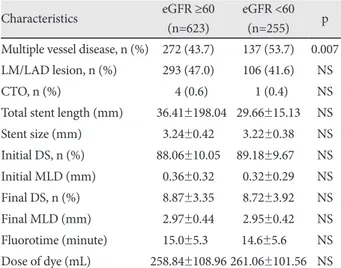308
Open Access
The Impact of Moderate to Severe Renal Insufficiency on Patients With Acute Myocardial Infarction
Jihyun Son, MD, Seung-Ho Hur, MD, In Cheol Kim, MD, Yun-Kyeong Cho, MD, Hyoung-Seob Park, MD,
Hyuck-Jun Yoon, MD, Hyungseop Kim, MD, Chang-Wook Nam, MD, Yoon-Nyun Kim, MD, and Kwon-Bae Kim, MD Department of Internal Medicine, College of Medicine, Keimyung University, Daegu, Korea
ABSTRACT
Background and Objectives: Renal insufficiency (RI) has been reported to be associated with unfavorable clinical out- comes in patients undergoing percutaneous coronary interventions (PCI). However, little data is available regarding the im- pact of moderate to severe RI on clinical outcomes in patients with acute myocardial infarction (AMI) undergoing PCI.
Subjects and Methods: Between March 2003 and July 2007, 878 patients with AMI who underwent PCI were enrolled.
Based on estimated glomerular filtration rate (eGFR) using the Modification of Diet in Renal Disease (MDRD) equation, pa- tients were divided into two groups: eGFR <60 mL/min·m
2(moderate to severe RI, group A) and eGFR ≥60 mL/min·m
2(nor- mal to mild RI, group B). The primary endpoint was all-cause mortality at 1-year after successful PCI. The secondary endpoints were non-fatal myocardial infarction (MI), target lesion revascularization (TLR), target vessel revascularization (TVR), stent thrombosis (ST) and major adverse cardiac events (MACE) at 1-year. Results: In group A, patients were more often male and older, with diabetes and hypertension. Compared to patients in group B, group A showed significantly higher incidences of all- cause mortality, cardiac mortality, non-fatal MI and MACE. The needs of TLR and TVR, and the incidence of ST were not sig- nificantly different between the two groups. Independent predictors of 1-year mortality were eGFR <60 mL/min·m
2, male gender, older age and a lower left ventricular ejection fraction. Conclusion: In patients with AMI, moderate to severe RI was associated with mortality and MACE at 1-year after successful PCI. In addition, eGFR <60 mL/min·m
2was a strong in- dependent predictor of 1-year mortality. (Korean Circ J 2011;41:308-312)
KEY WORDS: Renal insufficiency; Myocardial infarction; Percutaneous transluminal coronary angioplasty.
Received: July 6, 2010
Revision Received: September 8, 2010 Accepted: September 10, 2010
Correspondence: Seung-Ho Hur, MD, Division of Cardiology, Depart- ment of Internal Medicine, Keimyung University College of Medicine, Dong- san Medical Center, 216 Dalseong-ro, Jung-gu, Daegu 700-712, Korea Tel: 82-53-250-7998, Fax: 82-53-250-7034
E-mail: shur@dsmc.or.kr
• The authors have no financial conflicts of interest.
cc

